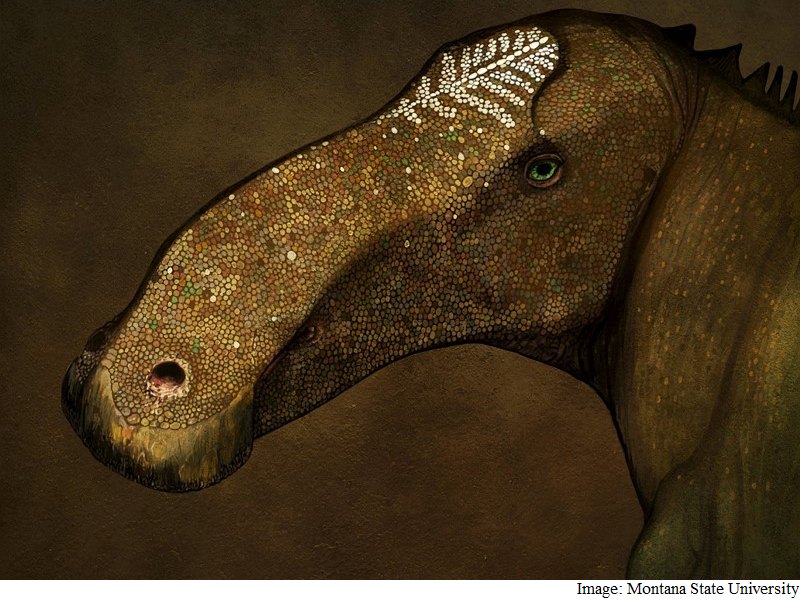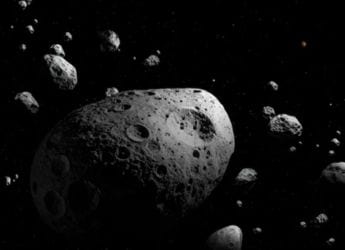- Home
- Science
- Science News
- 'Superduck' Dinosaur Provides Insight Into Elaborate Head Crests
'Superduck' Dinosaur Provides Insight Into Elaborate Head Crests
By Reuters | Updated: 13 November 2015 16:14 IST

Click Here to Add Gadgets360 As A Trusted Source

Advertisement
In a warm, lush environment near a meandering river 79.5 million years ago in Montana, a dinosaur nicknamed "Superduck" munched on leaves and kept a lookout for predators related to Tyrannosaurus rex that might threaten its herd.
Scientists on Wednesday announced the discovery of fossils of the dinosaur they named Probrachylophosaurus bergei that was about 30 feet (9 metres) long, weighed more than 5 tons and donned a small, triangular bony crest atop its skull.
It was a member of a plant-eating group called duck-billed dinosaurs, known for beaks resembling a duck's bill, common during the latter part of the Cretaceous Period.
Many duck-billed dinosaurs boasted head crests of various shapes and sizes. Probrachylophosaurus, one of the earliest with a prominent crest, offers insight into the evolution of these features, the researchers said.
Its skull bones are very similar to those of Acristavus, a duck-billed dinosaur from about 81 million years ago thought to be its ancestor, and Brachylophosaurus, which lived about 78 million years ago and is thought to be its descendant.
"Acristavus does not have a crest. The top of its skull is flat. Brachylophosaurus has a large, flat, paddle-shaped crest that completely covers the back of the top of its skull," said Elizabeth Freedman Fowler, curator of paleontology at the Great Plains DinosaurMuseum in Malta, Montana.
"It is a perfect example of evolution within a single lineage of dinosaurs over millions of years."
Paleontologist Jack Horner of Montana State University and the Museum of the Rockies added, "Because the fossil record is very spotty and we only get glimpses of evolutionary trends, it is always exciting to find evidence of transitional species."
Freedman Fowler said she gave Probrachylophosaurus (pronounced pro-BRAH-KEE-loh-foh-saw-rus) the nickname "Superduck" because it was pretty big for a duck-billed dinosaur, although not the largest.
Growth rings in its leg bones, akin to annual growth rings in trees, showed it was 14 years old, still not fully grown.
"We think that the crests of dinosaurs were visual signals so that they could recognize members of their own species, and also tell whether the animal was mature or not," Freedman Fowler said.
The scientists unearthed most of its skull, its pelvis, hind legs, vertebrae and ribs near the north-central Montana town of Rudyard. They unearthed less-complete remains of a second Probrachylophosaurus, more of an adolescent in age.
The research was published in the journal PLOS ONE.
© Thomson Reuters 2015
Scientists on Wednesday announced the discovery of fossils of the dinosaur they named Probrachylophosaurus bergei that was about 30 feet (9 metres) long, weighed more than 5 tons and donned a small, triangular bony crest atop its skull.
It was a member of a plant-eating group called duck-billed dinosaurs, known for beaks resembling a duck's bill, common during the latter part of the Cretaceous Period.
Many duck-billed dinosaurs boasted head crests of various shapes and sizes. Probrachylophosaurus, one of the earliest with a prominent crest, offers insight into the evolution of these features, the researchers said.
Its skull bones are very similar to those of Acristavus, a duck-billed dinosaur from about 81 million years ago thought to be its ancestor, and Brachylophosaurus, which lived about 78 million years ago and is thought to be its descendant.
"Acristavus does not have a crest. The top of its skull is flat. Brachylophosaurus has a large, flat, paddle-shaped crest that completely covers the back of the top of its skull," said Elizabeth Freedman Fowler, curator of paleontology at the Great Plains DinosaurMuseum in Malta, Montana.
"It is a perfect example of evolution within a single lineage of dinosaurs over millions of years."
Paleontologist Jack Horner of Montana State University and the Museum of the Rockies added, "Because the fossil record is very spotty and we only get glimpses of evolutionary trends, it is always exciting to find evidence of transitional species."
Freedman Fowler said she gave Probrachylophosaurus (pronounced pro-BRAH-KEE-loh-foh-saw-rus) the nickname "Superduck" because it was pretty big for a duck-billed dinosaur, although not the largest.
Growth rings in its leg bones, akin to annual growth rings in trees, showed it was 14 years old, still not fully grown.
"We think that the crests of dinosaurs were visual signals so that they could recognize members of their own species, and also tell whether the animal was mature or not," Freedman Fowler said.
The scientists unearthed most of its skull, its pelvis, hind legs, vertebrae and ribs near the north-central Montana town of Rudyard. They unearthed less-complete remains of a second Probrachylophosaurus, more of an adolescent in age.
The research was published in the journal PLOS ONE.
© Thomson Reuters 2015
Comments
Catch the latest from the Consumer Electronics Show on Gadgets 360, at our CES 2026 hub.
Related Stories
Popular on Gadgets
- Samsung Galaxy Unpacked 2025
- ChatGPT
- Redmi Note 14 Pro+
- iPhone 16
- Apple Vision Pro
- Oneplus 12
- OnePlus Nord CE 3 Lite 5G
- iPhone 13
- Xiaomi 14 Pro
- Oppo Find N3
- Tecno Spark Go (2023)
- Realme V30
- Best Phones Under 25000
- Samsung Galaxy S24 Series
- Cryptocurrency
- iQoo 12
- Samsung Galaxy S24 Ultra
- Giottus
- Samsung Galaxy Z Flip 5
- Apple 'Scary Fast'
- Housefull 5
- GoPro Hero 12 Black Review
- Invincible Season 2
- JioGlass
- HD Ready TV
- Laptop Under 50000
- Smartwatch Under 10000
- Latest Mobile Phones
- Compare Phones
Latest Gadgets
- OnePlus Turbo 6V
- OnePlus Turbo 6
- Itel Zeno 20 Max
- OPPO Reno 15 Pro Mini 5G
- Poco M8 Pro 5G
- Motorola Signature
- Vivo Y50e 5G
- Vivo Y50s 5G
- Lenovo Yoga Slim 7x (2025)
- Lenovo Yoga Slim 7a
- Realme Pad 3
- OPPO Pad Air 5
- Xiaomi Watch 5
- Huawei Watch 10th Anniversary Edition
- Acerpure Nitro Z Series 100-inch QLED TV
- Samsung 43 Inch LED Ultra HD (4K) Smart TV (UA43UE81AFULXL)
- Asus ROG Ally
- Nintendo Switch Lite
- Haier 1.6 Ton 5 Star Inverter Split AC (HSU19G-MZAID5BN-INV)
- Haier 1.6 Ton 5 Star Inverter Split AC (HSU19G-MZAIM5BN-INV)
© Copyright Red Pixels Ventures Limited 2026. All rights reserved.

















